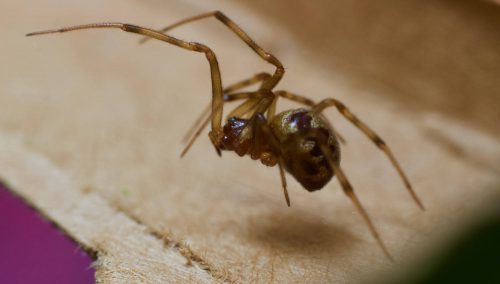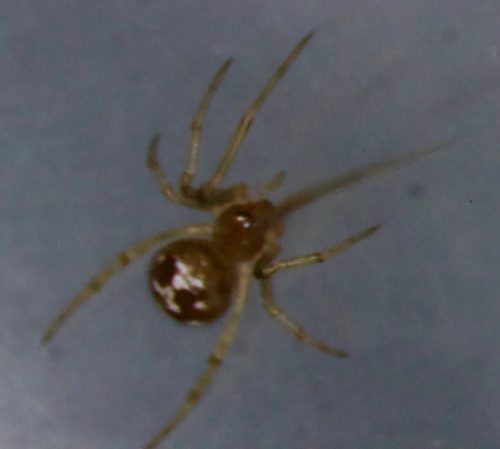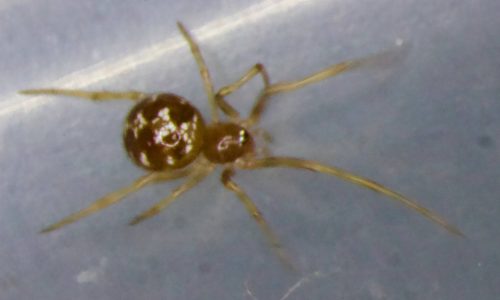I said I was going to tend to my shiny newborn Steatoda triangulosa today. It didn’t take as long as I expected. Here’s the vial of my freshly emerged spiderlings; the egg sac is the foamy looking bubble at the bottom, attached to the yellow plug on the vial, and the little dots are the babies.
There were only nine spiderlings from that egg sac. It was a bit of a surprise, since when a Parasteatoda egg sac pops, I easily get over a hundred spiderlings. It makes me wonder how well S. triangulosa does in the wild — I can tell you from our summer survey that they were the rarest of the false widows we found, with even S. borealis far more numerous, and they were a distant second to Parasteatoda. Now I’m curious about what niche they fill in the local spider ecosystem.
But still, I’m particularly interested in these guys. Why? Because they have such a consistent pigment pattern!
Here’s the adult. You can see a kind of zig-zag on their abdomen, which makes me think of Charlie Brown’s shirt. From a top view you would see triangles of white against a dark background, hence the name.
While Parasteatoda is more prolific, they also have a more complex and variable pigment pattern of dark streaks and blotches on a brown background. S. triangularis is simpler and I’d kind of like to examine the ontogeny of its ziggety-zags. Today, the feeble output of a mere 9 spiderlings can be seen here:
No abdominal pigment! You can see some of the banding appearing on the limb joints, though. Contrast that with these three juveniles, who are about a month old.
There’s some variability there, but you can see that all of them have formed a white “X” on the dorsal side of the abdomen. It’s a pattern! Developmental biologists love patterns. That’s something I could imagine being interesting to watch form, but it’s going to require daily mapping to catch the process. I don’t know now whether I should be happy or sad that they produce relatively few progeny, because the more spiders, the more work. Also, maybe you can’t tell from the stills, but in the movie it’s obvious — these are busy little beasties. They do not like to sit still for a photograph.
I may also have to eventually figure out what the pattern is in Parasteatoda, because there has to be one, it’s just fiddly as heck. It might be worthwhile to look at S. borealis, because it’s even simpler: they’re an overall dark purplish brown with a faint and variable horizontal stripe on the anterior abdomen. I’m also going to have to track down a few more wild individuals, which isn’t the easiest job — I think we saw S. triangulosa at only two houses in town. I’ll have to revisit before the frost comes!








Is the pattern necessarily in the human-visible spectrum? Maybe something more consistent pops out at UV wavelengths. Or maybe not.
Did someone eat their siblings?
Maybe you need a security camera to see what they get up to at night.
Along the lines of Marcu Ranum:
Are the egg cases the same size as their congeners?
Are the eggs themselves the same size?
Are the hatchlings the same size?
Can spiders hatch early within the case and do a little cannibalism before emerging?
oops, Marcus Ranum
“Steatoda Triangulosa” sounds like something Hermione Granger would say.
May a horde of Pompilidae nest in your Lab.
The mildly deranged penguin says that wasn’t an eggcase and those aren’t baby spiders, albeit the larger critter is a spider. The alleged eggcase is actually an emergency lifepod and the alleged baby spiders are refugees from an alien autocratic regime. They’ve flown, not completely under control, across many light-years of space, braving radiation, microparticles, the pew pew of the pursuing gunships, and a lack of cheese, succeeded with atmospheric entry and landing, mind-jacked a (possibly not cooperative) local resident with eight legs to help them, and now find themselves in some mad prefesser’s diabolical lab. She suspects they’re stymied — temporarily — as the lifepod and much of their kit appears not to have survived, and possibly because their trying to work out if the mad prefesser is friend, foe, or food, but will probably decide on a plan of action soon…
I counted the shed cuticles in the egg sac. There were 9. So no detectable fetal cannibalism here.
I found this link discussing Steatoda triangulosa. Seems the small number of offspring per egg sac is not abnormal, although 9 is smaller than the 30 they indicate is common (but with no idea how much that varies, it’s impossible to say if 9 is unusual or not.) I found it interesting that the species is native to Eurasia, and was estimated to have come to the Americas when the European invasion got underway. So a non-native species which doesn’t produce as many offspring per generation as our P. tep. friends…seems reasonable that they’d be harder to find.
MIsread…”colonization” is vague, it could mean the original colonization however long ago (which makes more sense in context.) Anyway, they haven’t been here long, comparatively speaking.
Don’t forget to swish and flick…